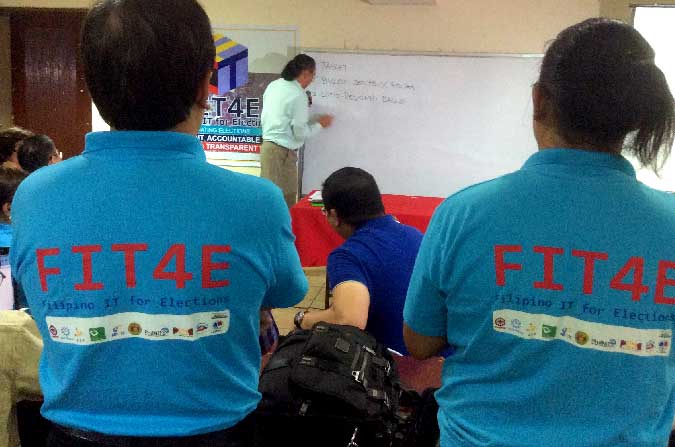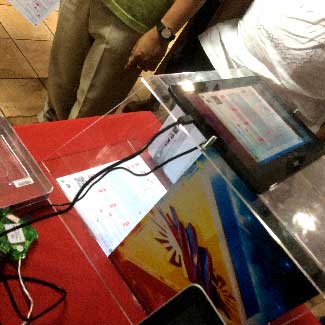Filipino IT can do it!
CenPEG.org
June 29, 2015
For the first time in the history of Philippine elections, two alternative election technology solutions were unveiled in a dry-run sponsored by the Automated Election System Watch (AES Watch) June 11, 2015 at the University of the Philippines’ Ang Bahay ng Alumni, Diliman, Quezon City. The dry run was co-sponsored by the office of the UP President, Alfredo Pascual, who served as the first spokesperson of AES Watch (2009-2010).

Developed by Filipino IT programmers, the two alternative election technology solutions unveiled by AES Watch were the Precinct Automated Tallying System (PATaS, acronym for fair) and TrAnsPArent election system (TAPAT, transparent and accurate). Formerly TcRES, PATaS was designed by an IT group under the TransparentElections.org, which is affiliated with AES Watch.
TAPAT, on the other hand, was developed by another IT group led by Toti Casiño, former president of the Philippine Computer Society (PCS), also with AES Watch. TAPAT aims to make election technology familiar to Filipino voters by using a Lotto-type ballot and a secrecy folder that contains the names and photos of candidates. In lieu of an expensive voting machine, the designers introduce the use of a GPS-precinct-specific tablet to scan, record, and transmit the votes.
Both alternative solutions integrate transparency and verification features, which were disabled under the Precinct Count Optical Scan (PCOS) system supplied by the Venezuelan marketing company, Smartmatic. Ownership issues and non-compliance with the minimum system requirements under the modern election law, RA 9369, resulted in questionable election results and inaccuracies in the 2010 and 2013 automated elections.
Both alternative Filipino-designed technologies are a lot cheaper compared to the costly PCOS. AES Watch said that adopting indigenous technologies for the automated election process would reduce costs by several fold allowing bigger budget allocations for Board of Election Inspectors (BEIs) or teachers who supervise every election with no commensurate and just pay. “Teachers first before the machine,” AES Watch leaders said.
The dry run was held to promote Filipino IT for Election (FIT4E), a movement launched on June 13, 2011 by AES Watch advocating for the inclusive participation of Filipino IT professionals, programmers, and scientists in designing alternative election solutions instead of outsourcing the country’s election system to untrusted and unaccountable foreign suppliers.
AES Watch clarified, as a broad, independent, and non-partisan citizens’ election watchdog, that it does not promote or market any specific Filipino-IT designed election technology or product. The watchdog only provides the venues, platforms, and forums to show that Filipino IT is more capable of developing our own automated election systems. CenPEG.news

.jpg)
Mock voting under PaTAS (CenPEG photo)

TAPAT ballot and voting machine (CenPEG photo)
.jpg)
TAPAT’s sample secrecy folder (CenPEG photo)
.jpg)
PaTAS transparent counting (CenPEG photo)
- Probing presidential platforms
- Conference calls for people-centered policy actions for Asian development and peace
- WWII 'comfort women' urge visiting Japanese emperor: OFFICIAL GOV’T APOLOGY, UPHOLD TRUTH, and JUST COMPENSATION
- FEARLESS FORECAST (EPISODE II): Comelec will not comply with e-Commerce Law in 2016 elections
- Fearless forecast: Comelec’s non-compliance with the AES law in 2016 (last of 2 parts)
- Fearless forecast: Comelec will not comply with the AES law in 2016
- CenPEG releases travelogue
- Experts: Nuisance bets reflect disillusionment, uneven playing field
- Partylist solon presses for tax cuts
- The True Cost of a Political Campaign
- Management decisions: Based on RA 9369 or purely Comelec’s?
- CenPEG holds 1st roundtable with media on presidential poll results
- Filipino IT can do it!
- FIT4E: The only transparent solution
- Realpolitik in the maritime tiff
- China’s challenge to PH sovereignty
- Choosing the next president
- Fixing the presidency, reforming the state
- New Comelec chair says he’s open to other election technologies
- SC ruling on AES Watch Pabillo and IBP vs Comelec, Smartmatic-TIM
- Comelec must explain P3.2B unliquidated cash advances
- CONGRESS ASKED TO HOLD DEMO ON PCOS HACKING
- 25 Bishops ask poll body to stop midnight deal with Smartmatic
- Pope Francis: reform and conversion
- 2 poll watch coalitions stage rally vs Comelec-Smartmatic midnight deal
- AES Watch questions Comelec-Smartmatic midnight deal
- ASEAN-India: Building Youth Partnerships through Culture and Entrepreneurship
- CenPEG forges research exchange and partnership with Jinan University
- FOI: Bearing fruit or foiled again?
- Remittance with Representation: The right to vote of overseas Filipinos
Center for People Empowewrment in Governance (CenPEG), Philippines. All rights reserved


